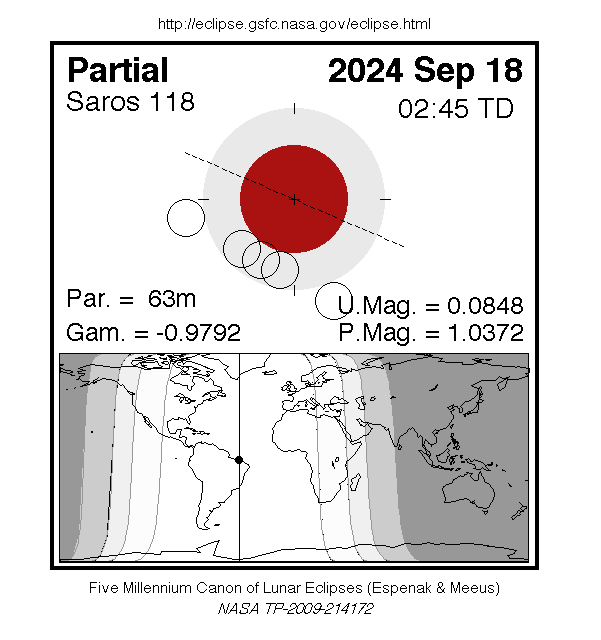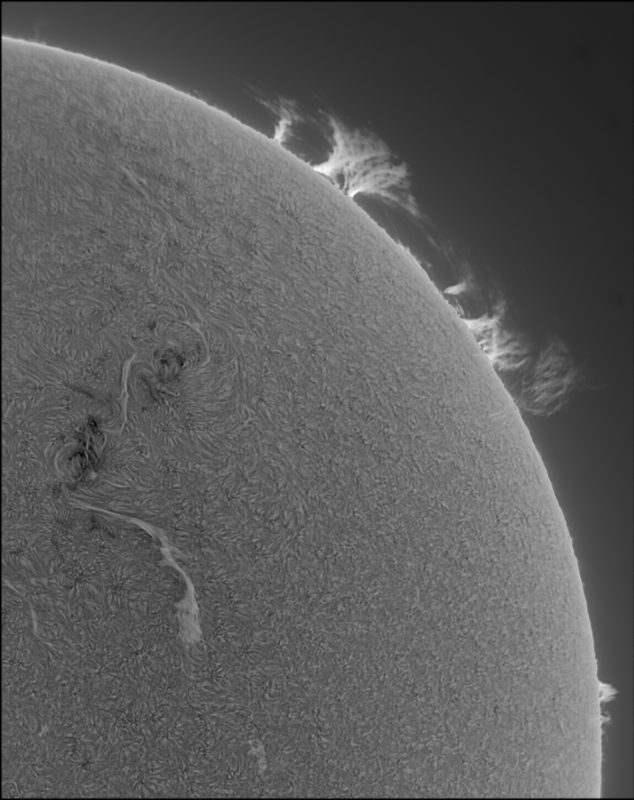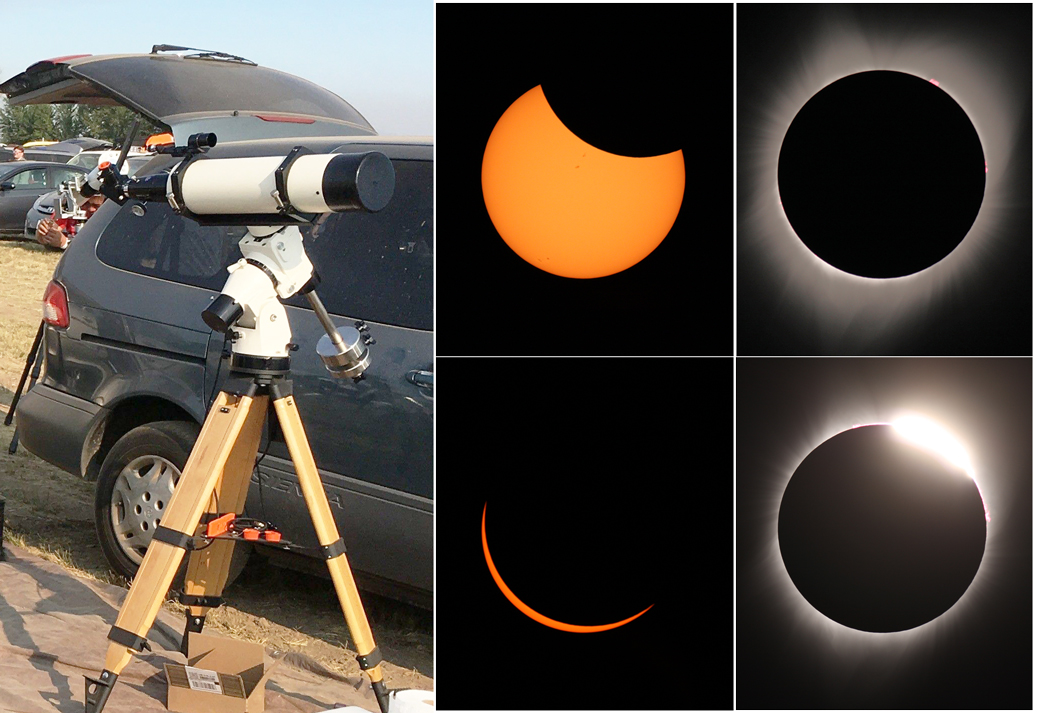2024 Sky Event Planner
Introduction
Solar events dominate the year with a major total solar eclipse over the Americas coinciding with the peak of Solar Cycle 25. On the other side of Earth’s terminator the nighttime sky features a brightening spring comet with hopes that other comets will brighten in summer and fall.
The Moon
The Moon this year will experience two lunar eclipses, a few Supermoons / Micromoons, and a Blue Moon (that probably won’t look blue). Use these events to take a fresh look at Earth’s nearest neighbor in space!
Lunar Eclipses
Let’s first review the types of Lunar Eclipses:
- Total Lunar Eclipses happen when the Moon passes through the umbral (inner) shadow of the Earth. This is the deepest shadow and can cause the Moon to turn red.
- Penumbral Lunar Eclipses happen when the Moon only passes through the large penumbral (outer) shadow of the Earth. This shadow is mixed with sunlight and only dims the Moon slightly.
- Partial Lunar Eclipses and phases happen when the Moon is not entirely inside the umbral shadow.

Because the Earth’s penumbral and umbral shadows are large at the distance of the Moon, the alignment of the Sun, Earth, and Moon two weeks before or after a solar eclipse is often close enough to cause a lunar eclipse. So, this year’s two lunar eclipses each happen two weeks before a solar eclipses. Unfortunately, these lunar eclipses won’t be spectacular.
Lunar Eclipse maps and data courtesy of Fred Espenak and Jean Meeus, “Five Millennium Canon of Lunar Eclipses: -1999 to +3000”. The top graphic shows the path of the Moon (circles) as it moves through the Earth’s penumbral (grey) and umbral (red) shadows. On the outline map of the Earth’s continents, the dark shaded areas do not see the eclipse, the lighter shaded areas will see part of the event, and white areas see the whole event. The black dot shows where the Moon is highest in the sky at Greatest eclipse. “TD” differs from “UT” by slightly over a minute. See Explanation Of Lunar Eclipse Figures page on NASA website for more information.

The Penumbral lunar eclipse of March 25th saw the Moon immerse itself in Earth’s penumbral shadow. This produced a dimming of the lunar surface that most people did not notice. The best visibility was in the Western hemisphere.
September 18th is technically a partial lunar eclipse because the extreme limb of the Moon will dip into Earth’s umbral shadow. However, most of the event will find the Moon wallowing in the less spectacular penumbral shadow. Best visibility is in the eastern half of North America, all of Central and South America, as well as Western Europe and Africa.
Supermoons, Micromoons, & Blue Moons

Due to the elliptical shape of the lunar orbit, the distance from the Earth to the Moon can vary by 50,200 km (31,200 mi). The term Supermoon describes a full Moon that occurs near the Moon’s closest approach to Earth (perigee) while Micromoon describes a full Moon near the point furthest from the Earth (apogee). A Supermoon can be 14% bigger than a Micromoon. The difference in size is very obvious in photographic comparisons.
There is no agreed-upon definition of how close and far a Moon needs to be to qualify for any of these designations, so sources may differ on the number of these Moons in a year. From our reckoning, these are the dates of the remaining Supermoons of the year with the date of perigee in parenthesis: September 17/18 (September 18), October 17 (October 16), November 15 (November 14), and December 15 (December 12). Remaining Micromoons for the year will happen on March 25 (March 23), April 23 (April 19/20), and May 23 (May 17).
The August 19 full Moon counts as a seasonal Blue Moon: the third of four full moons in a season. Blue moons occur on average once every 2.7 years Don’t expect the Moon to actually appear blue — unless you see it through a haze layer caused by a volcanic eruption.
The Sun
We are now in Solar Cycle 25, which was originally predicted to peak in July 2025. Most recent estimates say the peak will happen this year and have a higher sunspot count than the first prediction. In fact, we may be at Solar Maximum right now! We only know about the peak after the fact when solar activity dies down. See our Solar Update blog from March 2022 for more on the Solar Cycle and what solar features are visible through properly filtered solar telescopes.

Solar Eclipses
This is the third year in a row that a solar eclipse in April is followed by another one six months later in October. That three year cycle won’t repeat again until the year 2041. Let’s first review the types of Solar Eclipses:
- A Total eclipse happens when the Moon completely obscures the Sun for an observer.
- An Annular eclipse (from the word annulus or ring) happens when the Moon appears inside the disk of the Sun, but is too small to cover the Sun completely. This allows a ring of light from the Sun to shine around the lunar disk.
- Hybrid events happen when the eclipse appears Annular in some parts of the eclipse path and Total in another part.
- Partial eclipses and phases happen when the Moon obscures a part of the Sun while the lunar disk does not completely overlap the Solar disk.
Except for the moments of totality on the centerline of a total eclipse, viewers are cautioned to keep eclipse glasses on for these events.


Solar Eclipse maps and data courtesy of Fred Espenak and Jean Meeus, “Five Millennium Canon of Solar Eclipses: -1999 to +3000” (NASA/TP-2008-214170). Green lines denote limits of partial visibility. Blue line is the path of Totality. See Key to Solar Eclipse Figures for more information.
I’m sure many of our readers have researched the the Total Solar Eclipse of April 8 and have knowledge of the circumstances of the event (i.e., maximum duration will be 4′ 28″). But, how many of you knew the Moon will be at perigee the day before? Therefore, the event will feature a larger than average Super-New-Moon passing in front of the Sun. The eclipse will start in the warm waters of the South Pacific and head north to the Pacific beaches of Mexico. It will cross the border into Texas, where the shadow of totality will engulf or just skirt all major cities in the state save for Houston. It then passes though the Southern U.S. before entering the mid-West with the shadow of totality passing over Indianapolis and then over or close to every major city in Ohio before heading toward the Eastern Great Lakes region. Totality occurs over most of Lakes Erie and Ontario, along the highly populated U.S./Canada border, with the major metropolitan areas of Hamilton, Buffalo, Rochester, Syracuse and Montreal experiencing totality. The eclipse finishes its continental journey over southern Quebec, Northern Maine, then onto New Brunswick and Newfoundland, before ending in the cold waters of the North Atlantic. For many viewers, experiencing twilight at noon and sighting the Sun’s beautiful outer atmosphere, known as the corona, will be a once-in-a-lifetime event.

Six months later, on October 2, an Annular Solar Eclipse will create “ring of fire” around the darkened New Moon. Starting in the Northern Pacific Ocean, the path of totality will cross the equator and head south and cross the tip of South America into southern Chile and Argentina before ending off the coast in the chilly South Atlantic waters. While no solar corona will be visible, the duration will be a long 7′ 25″.
The Americas will have a bit of a wait before the next series of eclipses graces the skies. The next Total Eclipse over the Americas will take place in an arc encompassing Montana, Alberta, the Northwest Territories, and into Greenland in 2044. Just a year later, in 2045, a Total Eclipse will sweep over Pacific waters onto Northern California, and transit the U.S. before dipping into Gulf and Caribbean waters off the coast of Florida and heading into Guyana and northern Brazil. Please note these events down on your calendar so you don’t forget!

The Planets
Oppositions
Planets in opposition are in the sky opposite the Sun when viewed from Earth. They rise at sunset and are in the sky all night. Around opposition, the planets are closest to Earth and at their brightest. This makes opposition an opportune time to view and image a planet — especially the faint “ice giants” Uranus and Neptune. Note that only planets with orbits further away from the Sun than Earth’s orbit can be in opposition.


Mars won’t be in opposition until 2025 as we’re slowly chasing it around the Sun after sailing by it in 2022. But the slower-moving, major, outer planets will all have oppositions this year.
- Saturn: September 8
- Neptune: September 20/21
- Uranus: November 17
- Jupiter: December 7
Planetary Conjunctions and Occultations
Sometimes planets get close enough to each other to fit together in one eyepiece field or the Moon and a planet cozy up to each other. These are planetary conjunctions. There are also solar conjunctions (diagram above), but that just means that a body is near the Sun and impossible to see. Occultations happen when one body appears to go behind the other. The most easily visible of these events is when the Moon passes in front of a star or planet.
For the remainder of the year, here are some planetary conjunctions far enough from the Sun to be easily visible well above horizon obstructions for mid-northern latitude observers. Events listed are for objects within ½° (30′) of each other with at least one member of the pair easily visible naked eye, in binoculars, and low power telescope eyepieces. Objects will still be close in the days before and after the date given. In some parts of the world, the these conjunctions will be closer or even become lunar occultations where the object slides behind the Moon.
- May 31 morning: Conjunction of Moon and Saturn with the Moon 22′ south of Saturn. For mid-northern latitudes the pair will rise by 2 A.M..
- June 27 morning: Conjunction of Moon and Saturn with the Moon 4’38” north of Saturn. For mid-northern latitudes the pair will rise before midnight and be high in the sky by dawn.
- July 15 morning: Conjunction of Mars and Uranus with Mars 33′ (a little over a full-Moon width) south of the Ice Giant planet. The pair will rise a few hours before sunrise.
- July 24 morning: Conjunction of Moon and Saturn with the Moon 23′ north of Saturn. They will rise before 1 A.M. and be high in the sky by dawn.
- August 14 morning: Conjunction of Jupiter and Mars with Jupiter passing 18′ to the south of Mars. The pair will rise at 1 A.M. at mid-northern latitudes and be visible high in the pre-dawn sky.
- August 20: Conjunction of Moon and Saturn with the Moon 27′ north of Saturn. They will rise the previous night before 10 P.M and be highest in the sky after 2 A.M.
- September 17: Conjunction of Moon and Saturn with the Moon 18′ north of Saturn. They will rise the previous night before 8 P.M and be highest in the sky after midnight.
- October 14 evening: Conjunction of Moon and Saturn with the Moon 6’45” north of Saturn. They will be visible at sundown and set around 3 A.M. the next day.
- November 10 evening: Conjunction of Moon and Saturn with the Moon 5’18” north of Saturn. They will be visible at sundown and set around midnight.
- December 8 evening: Conjunction of Moon and Saturn with the Moon 18′ north of Saturn. They will be visible at sundown near their highest point in the sky and will set after 10 P.M.

Comets of Interest
Comet 12P/Pons–Brooks in the evening sky is an easy object for northern hemisphere observers. In the last days of March and beginning of April it will be passing by 2nd magnitude Hamal (alpha Ari) the brightest star in Aries. It will be lost in the solar glare in mid-April and reach perihelion on April 21, 2024 when it will be a southern hemisphere object. It is barely naked-eye in dark skies but is known to have outbursts of brightening. It should show easily in a telescope or large binocular.

In the autumn, comet C/2023 A3 Tsuchinshan–ATLAS, will swing through perihelion on 27 September 2024. Best viewing is around then and before sunrise when it is predicted to be easily naked eye. It will then become an evening object in October skies.
Did you observe, sketch, or image with Tele Vue gear? We’ll like your social media post on that if you tag it #televue and the gear used. Example:
#televue #tv85 #ethos #jupiter
Do you want your Tele Vue images re-posted on Tele Vue Optics’ Social Media accounts? Use this hashtag for consideration:
#RPTVO











